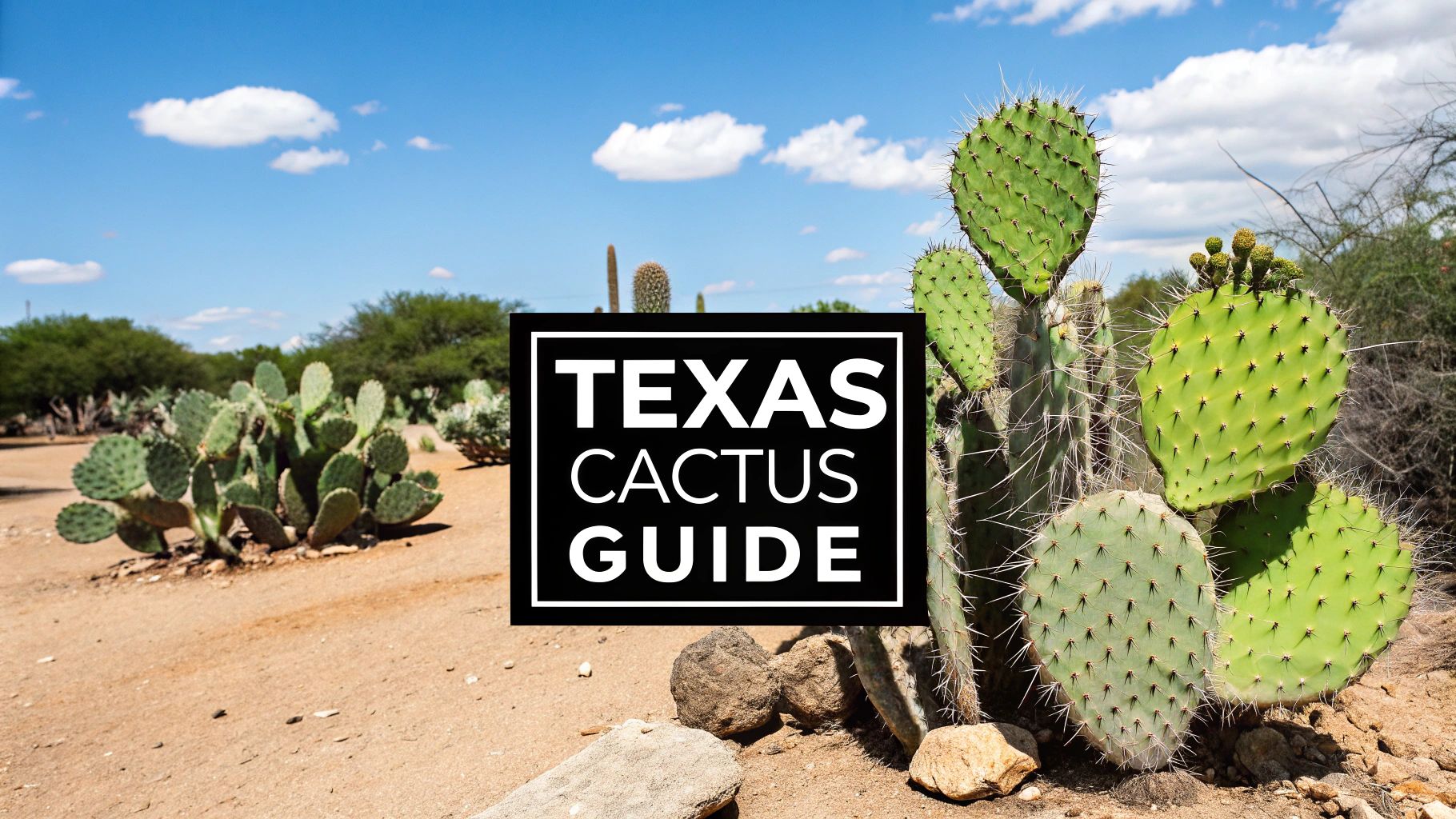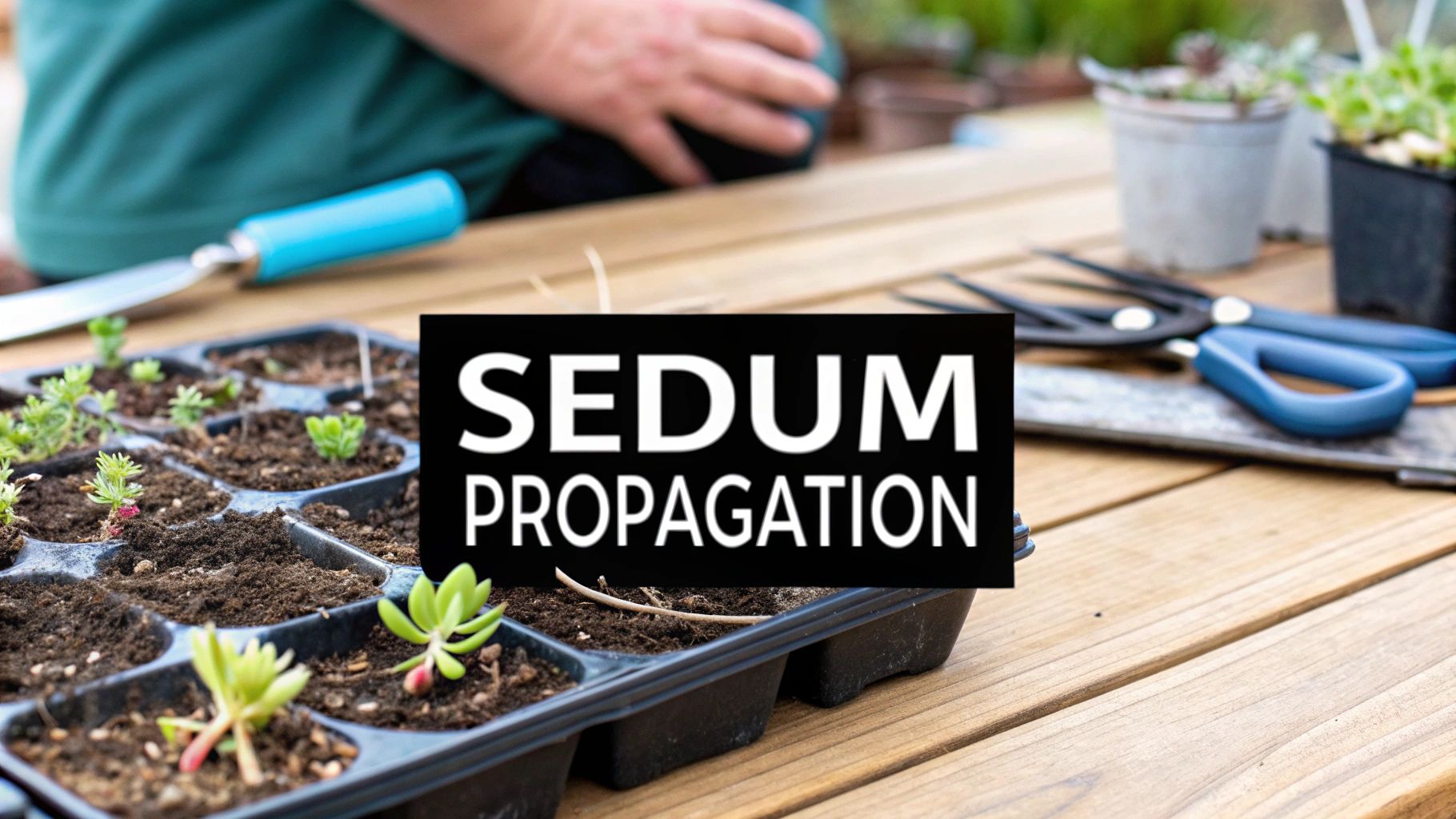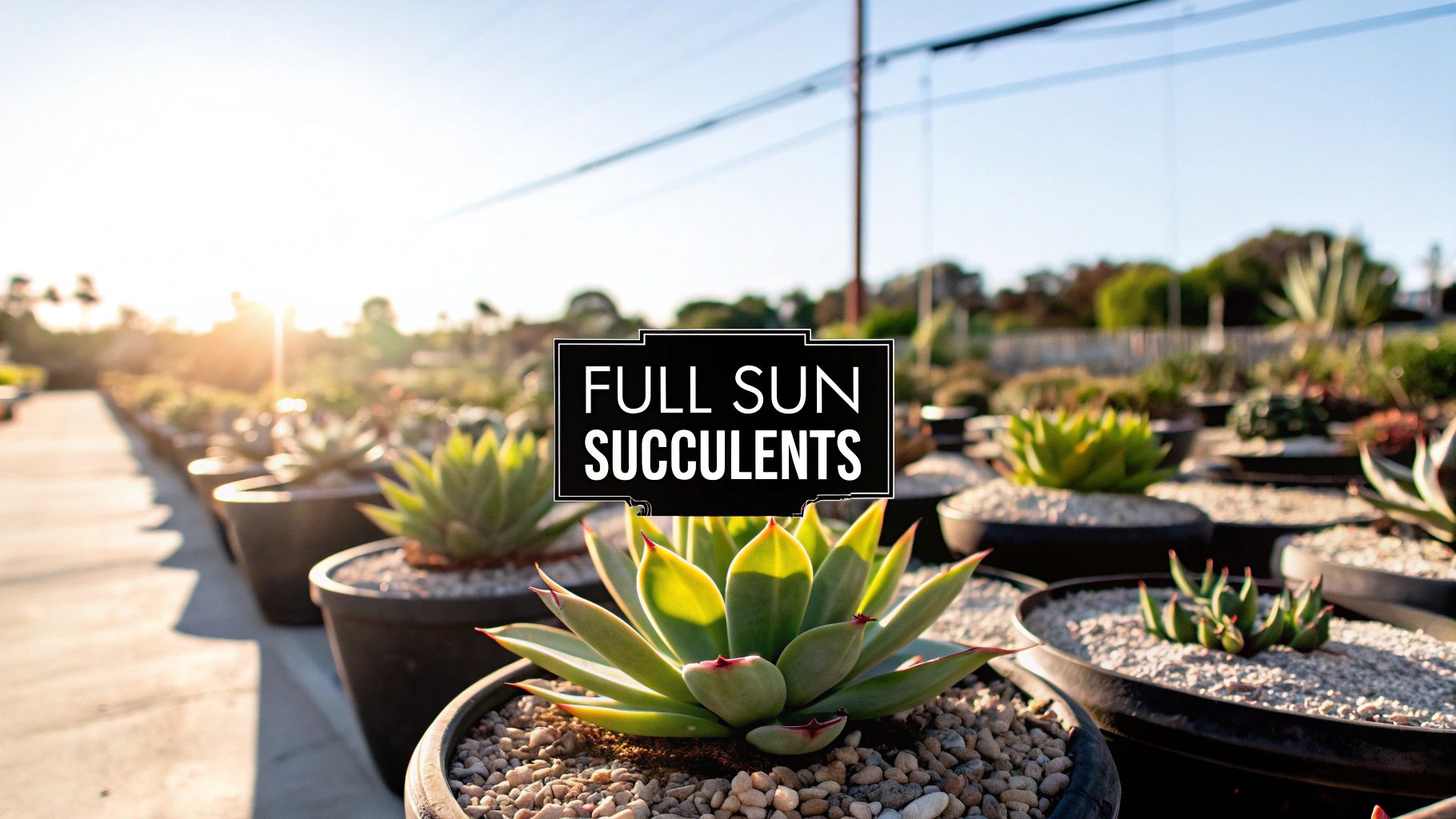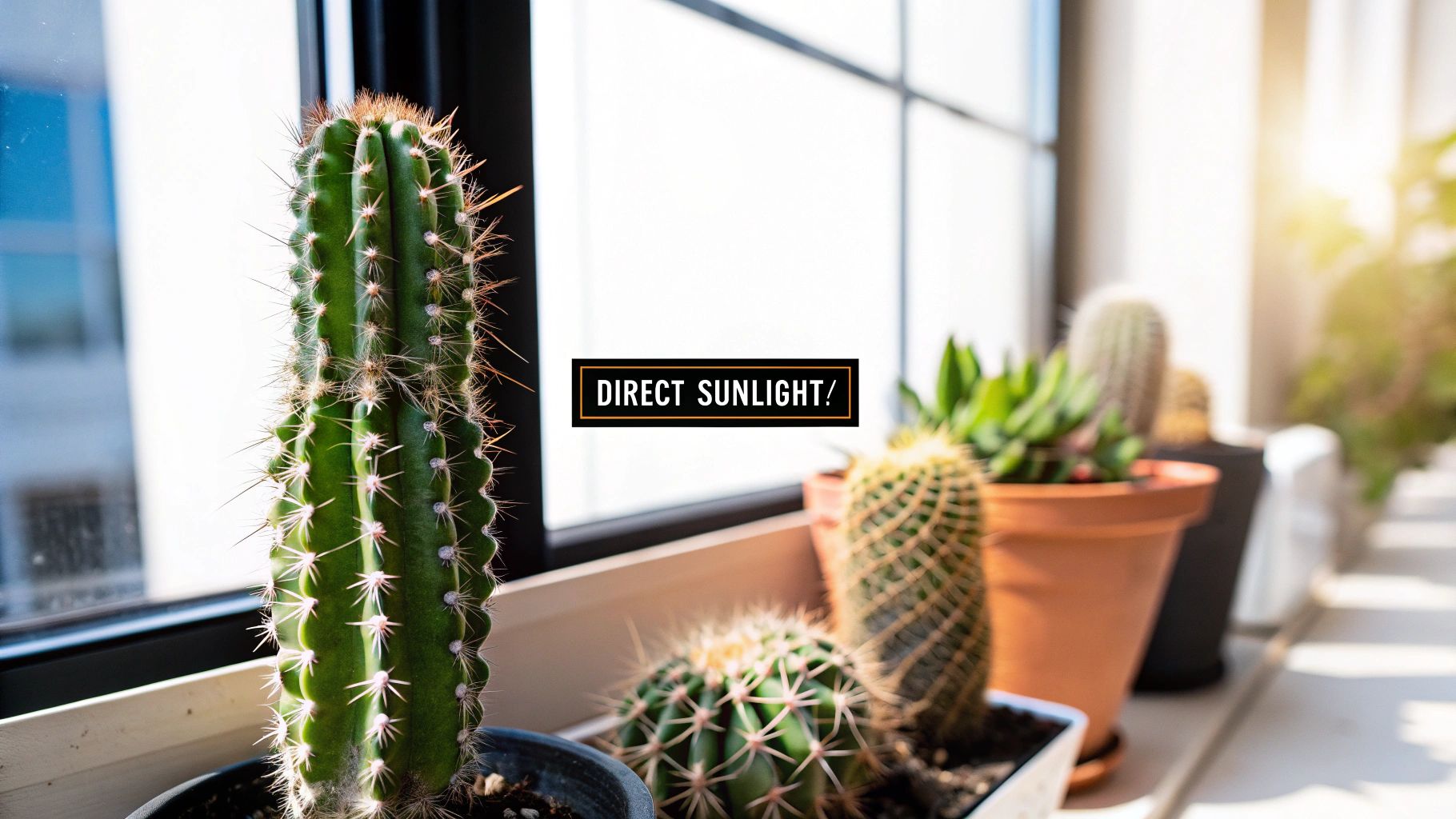When picturing Texas, the silhouette of a cactus against a fiery sunset is an iconic image. However, the Lone Star State’s vast and varied landscape supports a far greater diversity of cacti than just the classic, paddle-shaped Prickly Pear. From the arid Chihuahuan Desert in the west to the humid subtropics of the Gulf Coast, Texas is a natural habitat for a stunning array of succulent life, each with unique characteristics and ecological significance.
This guide moves beyond the stereotype to explore nine of the most common and fascinating types of cactus in Texas. For each species, we will provide clear identification features, details on their native habitats, and practical care tips for home gardeners and landscape designers. Whether you are a seasoned botanist looking to identify a specific specimen or a homeowner seeking a drought-tolerant addition to your garden, this list offers actionable insights. You will learn to distinguish between the formidable Horse Crippler and the delicate Texas Rainbow Cactus, gaining a new appreciation for the resilience and beauty of these spiny residents. This comprehensive roundup is designed to be your go-to resource for understanding and cultivating the diverse cacti that define the Texas terrain.
1. Prickly Pear Cactus (Opuntia species)
When discussing the types of cactus in Texas, the Prickly Pear is undeniably the most iconic. This incredibly resilient plant, belonging to the Opuntia genus, is easily identified by its distinctive flat, paddle-like segments known as cladodes. These pads are covered in both large, fixed spines and tiny, hair-like glochids that detach easily, so handling them requires caution.
In spring, the Prickly Pear puts on a stunning display of vibrant flowers, typically in shades of yellow, pink, or red. These blossoms eventually give way to bulbous, magenta-colored fruits called "tunas," which are a vital food source for wildlife and humans alike. Its remarkable adaptability allows it to thrive in diverse environments across the state, from the arid Chihuahuan Desert to the humid Gulf Coast prairies.
Widespread and Versatile Use
The Prickly Pear is much more than just a decorative plant; it is a cornerstone of Texas's ecological and cultural landscape. Its practical applications are numerous:
- Xeriscaping: Homeowners across Texas suburbs frequently use it in drought-tolerant landscaping.
- Culinary Staple: The young pads, called nopales, are a staple in Mexican-American cuisine, and the fruits are used to make jellies, candies, and juices.
- Natural Barrier: Its dense, spiny growth makes it an effective natural fence for livestock and property lines.
Here is a quick reference summarizing the Prickly Pear's key characteristics.

This infographic highlights the cactus's statewide presence and its dual purpose as both an ornamental and edible plant. For those interested in cultivating this Texas native, successful growth hinges on a few key practices. Ensure it is planted in sandy, well-draining soil with ample sunlight. To learn more about how to successfully cultivate this versatile plant, you can find a detailed guide on how to grow a Prickly Pear cactus.
2. Cholla Cactus (Cylindropuntia species)
Another one of the most recognizable types of cactus in Texas is the Cholla, belonging to the Cylindropuntia genus. This cactus has a distinctive, almost tree-like appearance, characterized by its segmented, cylindrical stems covered in formidable, barbed spines. Often called the "jumping cactus," its segments detach with the slightest touch, readily clinging to clothing or fur, which serves as its primary method of propagation.
In the spring and early summer, Chollas produce beautiful, brightly colored flowers, often in shades of green, yellow, or purplish-pink. These blossoms are a crucial nectar source for pollinators and mature into fleshy, often spiny, fruits. Species like the Tasajillo (Cylindropuntia leptocaulis) and Tree Cholla (Cylindropuntia imbricata) are common sights in the arid landscapes of West and South Texas, playing a key role in the desert ecosystem.
A Striking and Functional Addition
Beyond its intimidating reputation, the Cholla cactus offers both aesthetic appeal and practical benefits, making it a significant plant in the Texas landscape. Its unique structure provides shelter for birds and other desert wildlife.
- Architectural Accent: Its sculptural form makes it a dramatic focal point in xeriscaped gardens, particularly in regions like El Paso and the Trans-Pecos.
- Defensive Barrier: The dense, spiny branches create an impenetrable natural fence, effectively used as a security barrier or to contain livestock on ranches.
- Wildlife Habitat: Birds, such as the cactus wren, often build their nests within the protective spines of the Cholla, safe from predators.
Due to its aggressive spines, careful planning is essential when incorporating Cholla into a landscape. Always plant it away from walkways, play areas, and other high-traffic zones. Handling requires thick, leather gloves and tongs to avoid injury. To learn more about identifying different Cholla species, the National Park Service provides helpful resources on the plants of Big Bend National Park.
3. Barrel Cactus (Ferocactus species)
Among the most visually striking types of cactus in Texas is the Barrel Cactus. Belonging to the Ferocactus genus, these plants are known for their distinctive rounded or cylindrical shape, which can grow to impressive sizes over many decades. Their stout bodies are defined by prominent, deep ribs lined with formidable spines, often arranged in intricate geometric patterns. The most common species found in the state is the Turk's Head Cactus (Ferocactus hamatacanthus).
These slow-growing desert dwellers are a sight to behold, especially when they bloom. In late spring or summer, a crown-like ring of vibrant yellow or reddish flowers emerges at the very top of the plant, adding a splash of brilliant color to their rugged form. Their solitary, statuesque presence makes them a popular focal point in desert landscapes and botanical gardens across Texas.

A Sculptural Desert Centerpiece
The Barrel Cactus is highly valued for its dramatic, sculptural quality, making it a sought-after specimen for xeriscaping and container gardening. It serves as a living work of art that embodies the spirit of the Southwestern desert.
- Landscape Accent: Landscape designers in Austin and El Paso frequently use them as a stunning centerpiece in drought-tolerant gardens.
- Collector's Item: Its unique form and long lifespan make it a prized possession for cactus collectors in private South Texas gardens.
- Educational Displays: Nature centers use the Barrel Cactus to teach visitors about desert adaptation and plant biology.
For enthusiasts looking to add this architectural plant to their collection, proper care is crucial. Provide excellent drainage with a gritty soil mix, protect it from hard freezes, and allow plenty of space for it to reach its mature size. Water deeply but infrequently, allowing the soil to dry out completely between waterings. To discover more about the various kinds available, you can explore the different types of Barrel Cacti and their specific needs.
4. Night-Blooming Cereus (Epiphyllum oxypetalum)
While many types of cactus in Texas are known for their sun-loving, arid-adapted nature, the Night-Blooming Cereus, or "Queen of the Night," offers a dramatically different experience. This epiphytic cactus, Epiphyllum oxypetalum, features long, flat, leaf-like stems that climb or trail, making it a unique specimen. Its true claim to fame is its spectacular floral display: enormous, intensely fragrant white flowers that bloom for a single night.
This fleeting event, where the huge blossoms open after dusk and wilt by sunrise, is a celebrated occasion for plant enthusiasts. The stunning beauty and sweet aroma of the blooms often inspire Texans to host "blooming parties," gathering friends and neighbors to witness the brief but unforgettable spectacle. Its nocturnal magic and ethereal appearance make it one of the most sought-after cacti in the state.

An Unforgettable Horticultural Event
The Night-Blooming Cereus is more than a plant; it's a living event that creates lasting memories and fosters community. Its rare blooming cycle has become a focal point for social gatherings and botanical fascination.
- Botanical Garden Highlights: The San Antonio Botanical Garden often announces bloom events, drawing crowds to witness the mass flowering.
- Neighborhood Gatherings: In suburbs from Houston to Austin, homeowners invite neighbors over for impromptu nighttime parties to share the experience.
- Social Media Buzz: The short-lived bloom is a popular subject on social media, with Texans sharing photos and time-lapses of the flower opening.
The following video showcases the mesmerizing process of a Night-Blooming Cereus flower opening over several hours, condensed into a short time-lapse.
Successfully cultivating this plant requires mimicking its native tropical environment. Unlike desert cacti, it needs partial shade, higher humidity, and well-draining but rich soil. To catch the bloom, watch for large, drooping buds and prepare to stay up late; the show is well worth the wait.
5. Christmas Cactus (Schlumbergera species)
While not a native desert dweller, the Christmas Cactus has become a beloved household fixture across Texas, adding a splash of color during the winter months. This plant, part of the Schlumbergera genus, is an epiphytic cactus from the coastal mountains of Brazil. Unlike other types of cactus in Texas, it lacks sharp spines and grows in segmented, flat stems that cascade gracefully over the sides of its container.
The Christmas Cactus is famous for its stunning, tubular flowers that bloom in vibrant shades of pink, red, white, or purple. Its blooming cycle is triggered by cooler temperatures and shorter daylight hours, which is why it reliably puts on its spectacular show around the winter holidays. This unique characteristic makes it a cherished living decoration in many Texas homes.
A Cherished Holiday Tradition
The Christmas Cactus is more than just an ornamental houseplant; it is deeply woven into the fabric of holiday traditions and community life in Texas. Its uses are primarily celebratory and sentimental:
- Holiday Decor: It is a popular, low-maintenance alternative to poinsettias for festive indoor decoration.
- Family Heirlooms: These long-lived plants are often passed down through generations, becoming a living family legacy.
- Community Fundraising: They are frequently sold at school and church plant sales during the holiday season as popular gifts.
Here is a quick reference summarizing the Christmas Cactus's key characteristics.
This infographic highlights the cactus's role as a popular indoor plant and its seasonal blooming nature. For those wanting to ensure vibrant holiday blooms, a few specific care tips are essential. Provide it with well-draining soil and bright, indirect light. To learn more about triggering its famous flowers, you can find a detailed guide on how to care for a Christmas Cactus.
6. Pencil Cactus (Euphorbia tirucalli)
While not a true cactus, the Pencil Cactus is a popular succulent that has found a firm place among the types of cactus in Texas landscaping. Belonging to the Euphorbia genus, this plant is notable for its unique structure, consisting of slender, pencil-like green branches that grow in a dense, upward fashion. This creates a striking architectural form that adds a modern touch to gardens and homes.
A fascinating feature of the Pencil Cactus is the way its tips can turn a vibrant red or orange when exposed to bright sunlight or cooler temperatures, providing dynamic seasonal interest. It's important to note that the plant produces a milky white latex sap when broken, which is a skin and eye irritant. Handling this plant requires care and protective gloves.
A Modern and Architectural Accent
The Pencil Cactus's unusual appearance makes it a favorite for contemporary designs, where its clean lines and vertical growth stand out. It serves various aesthetic and practical purposes across Texas:
- Modern Landscaping: Its minimalist form is frequently used as a focal point in modern landscape designs in Austin and Dallas.
- Container Gardening: It thrives as a container specimen on patios in Houston, where it can be easily protected from frost.
- Indoor Decor: The plant's low-water needs and striking shape make it a popular indoor specimen in homes throughout South Texas.
Here is a quick reference summarizing the Pencil Cactus's key characteristics.
This infographic highlights the cactus's popularity in contemporary design and its need for frost protection. For those interested in adding this architectural succulent to their collection, successful growth depends on a few key considerations. Provide it with bright, indirect light and well-draining soil, and always protect it from freezing temperatures. To explore other similar plants, you can find a guide on the various types of Euphorbia.
7. Texas Rainbow Cactus (Echinocereus dasyacanthus)
Among the most visually striking types of cactus in Texas is the Texas Rainbow Cactus. This small, cylindrical cactus earns its name from the dense, multicolored spines that form distinct bands of white, pink, yellow, and brown along its stem, creating a rainbow-like effect. It typically grows in clusters, adding a unique texture and form to the arid landscape.
In spring, the Texas Rainbow Cactus produces disproportionately large and showy flowers, usually bright yellow with a reddish-orange center. Also known as the Spiny Hedgehog Cactus, this species is perfectly adapted to the limestone-rich soils and dramatic temperature swings characteristic of West Texas and the Hill Country. Its vibrant appearance makes it a prized specimen for collectors and native plant enthusiasts.
A Jewel of Native Gardens
The Texas Rainbow Cactus is more than just a desert survivor; it's a celebrated ornamental that brings vibrant color to xeriscapes and rock gardens. Its compact size and stunning features make it highly versatile.
- Rock Gardens: Its clustering habit and colorful spines make it an excellent focal point in native rock and gravel gardens, especially in the Austin area.
- Container Gardening: Due to its modest size and slow growth, it is perfectly suited for pots and containers on sunny patios.
- Conservation Plantings: State parks and wildflower centers often feature it in displays to showcase Texas's native biodiversity and promote water-wise landscaping.
Here is a quick reference summarizing the Texas Rainbow Cactus's key characteristics.
This infographic would highlight the cactus's specific habitat in limestone soils and its role as a prized ornamental. For gardeners looking to add this native gem to their collection, successful cultivation depends on mimicking its natural environment. Ensure it is planted in gravelly, well-draining soil and protected from excessive summer moisture. Planting in the fall is often recommended to allow for strong root establishment before the spring blooming season. To see this cactus in its natural glory, one might visit the Wildflower Center at UT Austin, which often features native flora.
8. Horse Crippler Cactus (Echinocactus texensis)
The Horse Crippler Cactus, a formidable entry in any list of types of cactus in Texas, gets its name for good reason. Belonging to the Echinocactus genus, this low-profile, almost flat cactus often hides in the prairie grasses of its native habitat. Its stout, curved, and incredibly sharp spines can easily injure the hooves and legs of unsuspecting livestock and humans, making it a plant to admire from a distance.
Despite its menacing name, the Horse Crippler is a beautiful specimen. It is a solitary, ribbed cactus that can grow up to a foot in diameter but rarely more than a few inches tall. In late spring, it produces a stunning crown of delicate, pink to magenta flowers near its apex, creating a striking contrast with its rugged, spiny body. These blooms later develop into woolly, reddish fruits that provide food for wildlife.
A Keystone Prairie Species
The Horse Crippler is more than just a spiny hazard; it is a vital component of Texas's grassland and prairie ecosystems. Its presence indicates a healthy, undisturbed native landscape.
- Prairie Restoration: Conservationists use this cactus in native plant restoration projects to help re-establish authentic Texas prairie habitats.
- Educational Displays: Texas nature centers and botanical gardens often feature it to educate the public about the state's unique and resilient flora.
- Wildlife Support: The cactus provides shelter for small lizards and insects, while its fruits are consumed by various animals.
Here is a quick reference summarizing the Horse Crippler's key characteristics.
This cactus is a fascinating example of adaptation, thriving in the harsh conditions of open, sun-drenched prairies. For those considering it for a specialized rock garden or restoration project, its specific needs are critical. It demands excellent drainage and minimal disturbance. To learn more about this and other barrel-type cacti, you can explore resources from organizations like the Cactus and Succulent Society of America.
9. Claret Cup Cactus (Echinocereus triglochidiatus)
Among the most visually striking types of cactus in Texas, the Claret Cup Cactus is celebrated for its breathtaking floral displays. This species, belonging to the Echinocereus genus, grows in dense clusters of ribbed, cylindrical stems that can form impressive mounds over time. The name "Claret Cup" is a nod to its spectacular, cup-shaped flowers that boast a brilliant scarlet or deep orange-red hue.
These vibrant blooms typically appear in spring, creating a vivid contrast against the cactus's green stems and creating a beacon for pollinators, especially hummingbirds. What makes Echinocereus triglochidiatus particularly notable is its hardiness; it can tolerate more cold and moisture than many of its desert counterparts, allowing it to flourish in a broader range of Texas climates, from the high deserts of West Texas to rock gardens further east.
A Hummingbird Magnet and Garden Jewel
The Claret Cup is prized not just for its beauty but for its role in the garden ecosystem and its resilience. It's a favorite in xeriscaped and native plant gardens.
- Rock Gardens: Its mounding habit and tolerance for well-drained, rocky soil make it an ideal specimen for rock gardens, such as those seen in Dallas-area landscapes.
- Wildlife Attraction: The bright, tubular flowers are perfectly shaped for hummingbirds, making it a star player in pollinator gardens from Austin to El Paso.
- Container Planting: Due to its manageable size and slow growth, it performs exceptionally well in containers on sunny patios.
Here is a quick reference summarizing the Claret Cup's key characteristics. Plant it in a location with full sun and excellent air circulation to promote the best flowering. One of the keys to encouraging its stunning blooms is to allow it to experience a cool, dry winter dormancy period. For a deeper look into its care, especially in different climate zones, you can find helpful tips on specialized cactus forums.
Comparison of 9 Texas Cactus Types
| Cactus Species | Implementation Complexity 🔄 | Resource Requirements ⚡ | Expected Outcomes 📊 | Ideal Use Cases 💡 | Key Advantages ⭐ |
|---|---|---|---|---|---|
| Prickly Pear Cactus | Moderate - hardy, but requires spacing | Low - drought tolerant, low care | Erosion control, food source, pollinator attractor | Xeriscaping, food production, erosion | Highly drought tolerant, edible parts |
| Cholla Cactus | High - handling requires care | Moderate - protective gear needed | Wildlife habitat, natural barriers | Security barriers, xeriscaping focal point | Unique form, excellent habitat |
| Barrel Cactus | Low to Moderate - slow growth | Low - minimal water, long life | Striking specimen plant, long-lived | Botanical gardens, collector displays | Spectacular form, heat tolerant |
| Night-Blooming Cereus | High - needs specific conditions | Moderate - partial shade, humidity | Dramatic night blooms, fragrant flowers | Ornamental, social gathering events | Unique bloom, fragrant, conversation piece |
| Christmas Cactus | Moderate - indoor care needs | Moderate - indirect light, watering | Reliable holiday blooms indoors | Indoor holiday decoration | Easy propagation, long-lived |
| Pencil Cactus | Low - fast growing, minimal care | Low - drought tolerant | Architectural landscaping, seasonal color | Modern landscapes, containers | Fast growth, unique architectural form |
| Texas Rainbow Cactus | Moderate - slow growing, needs drainage | Low - adapted to harsh soils | Spectacular flowers, native pollinator attractor | Native plant gardens, conservation | Native species, cold hardy |
| Horse Crippler Cactus | Moderate - dangerous spines, slow growth | Low - drought tolerant | Prairie ecosystem component, unique form | Prairie restoration, education | True native, beautiful flowers |
| Claret Cup Cactus | Moderate - slow to establish clusters | Low - drought tolerant | Brilliant red flowers, long-lived | Botanical gardens, hummingbird gardens | Spectacular flowers, cold hardy |
Cultivating Your Own Texas Cactus Collection
Our journey through the diverse world of Texas cacti has revealed a landscape far richer and more varied than many imagine. From the iconic silhouette of the Prickly Pear to the elusive, breathtaking bloom of the Night-Blooming Cereus, we've explored species that define the state's rugged beauty. We've seen how the formidable Horse Crippler earned its name and how the vibrant Claret Cup brings a splash of fiery red to arid environments. Each cactus tells a story of adaptation, survival, and unexpected elegance.
The key takeaway is that the incredible variety of types of cactus in texas offers something for every enthusiast. Whether you are a landscape designer planning a drought-tolerant garden or a homeowner looking for a low-maintenance, sculptural houseplant, the perfect specimen exists. Understanding the fundamental differences, from the segmented pads of an Opuntia to the ribbed globe of a Ferocactus, is the first step toward successful cultivation.
Actionable Next Steps for Aspiring Collectors
Feeling inspired? Turning your newfound knowledge into a thriving cactus collection is easier than you think. Here are your next steps:
- Assess Your Environment: First, evaluate your specific growing conditions. Do you have a sun-drenched patch of land in West Texas perfect for a Barrel Cactus, or a bright, indirect-light corner in an East Texas apartment ideal for a Christmas Cactus? Matching the plant to the place is the most critical factor for success.
- Start with a 'Forgiving' Species: If you are new to cacti, begin with a resilient and common type like a Prickly Pear or a Texas Rainbow Cactus. These species are generally more tolerant of occasional overwatering or inconsistent care, allowing you to learn and build confidence.
- Prioritize Proper Soil and Drainage: No matter which Texas cactus you choose, success hinges on one non-negotiable factor: excellent drainage. Invest in a high-quality cactus and succulent soil mix, or create your own by amending potting soil with perlite, pumice, or coarse sand. Ensure your pots have ample drainage holes to prevent root rot, the number one enemy of these arid-adapted plants.
Bringing the Texas Landscape Home
Cultivating these plants is more than just gardening; it's about connecting with the resilient spirit of the Texas ecosystem. Each new spine, pad, or flower is a testament to nature's ability to create beauty in the harshest conditions. By bringing these structural wonders into your home or landscape, you are not just adding a decorative element-you are curating a living sculpture that embodies strength and minimalist grace. Embracing the diverse types of cactus in texas is an invitation to appreciate the profound and often overlooked artistry of the natural world.
Ready to find the perfect specimen to start or expand your collection? The Cactus Outlet offers an extensive, expertly-curated selection of healthy, high-quality cacti native to Texas and beyond. Explore their inventory to find the exact species you’ve learned about and get it shipped directly to your door. Visit The Cactus Outlet to begin your own desert-inspired horticultural adventure.




